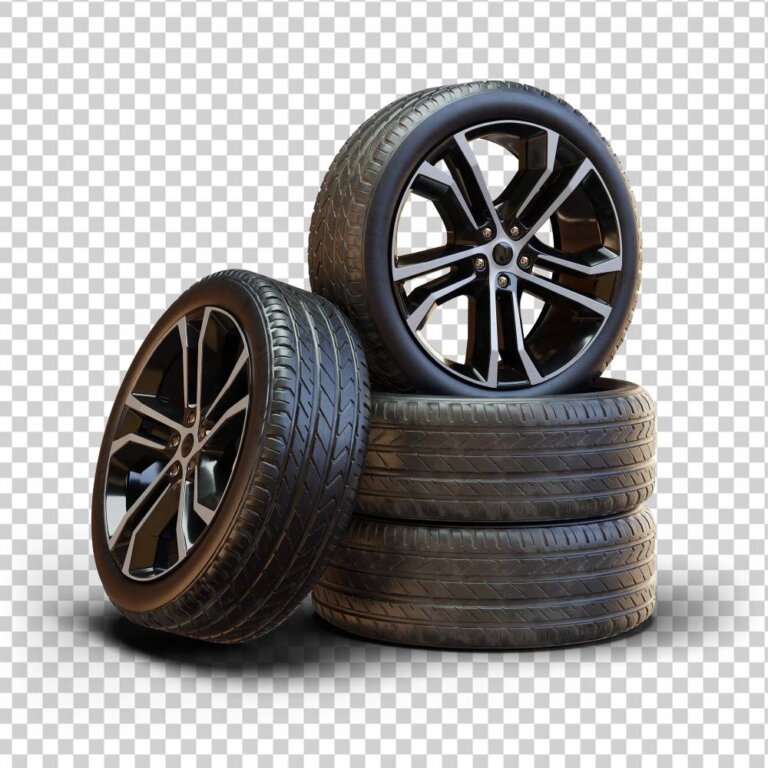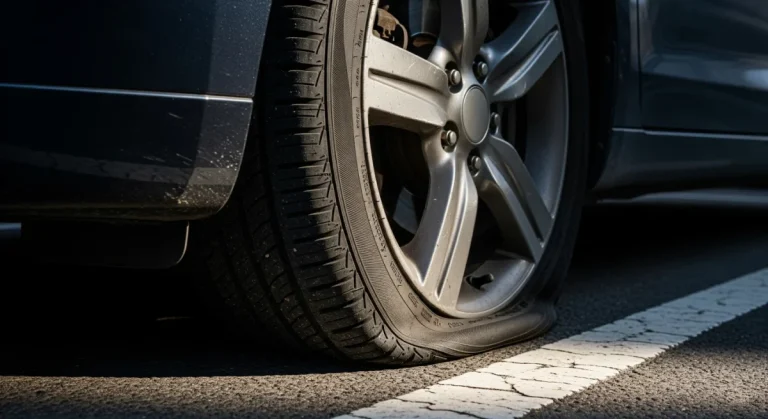How to Fix a Bubble in a Tire: An ASE-Certified Master Technician’s Guide
Key Takeaways
- EXTREME DANGER: A tire bubble signifies a critical failure of the tire’s internal structure. While understanding how to fix a bubble in a tire is essential, it is a weak spot that can lead to a sudden, dangerous blowout at any time, especially at high speeds.
- NO REPAIRS, ONLY REPLACEMENT: A tire bubble cannot be safely repaired. Patches, plugs, or any other method are ineffective and create a false sense of security. The only safe solution is to replace the entire tire.
- STOP DRIVING IMMEDIATELY: If you see a bubble, your first action is to pull over safely. Do not attempt to “make it home” or drive to a tire shop. Change to your spare tire or call for roadside assistance.
- IMPACT IS THE USUAL CULPRIT: Most bubbles are caused by severe impacts from hitting potholes, curbs, or road debris. The best prevention is maintaining correct tire pressure and avoiding such hazards whenever possible.
Few things make a driver’s heart sink faster than spotting something wrong with their car, especially when it’s a tire. If you’ve just noticed a strange, unsettling bulge on your tire’s sidewall, you’re right to be concerned.
My name is David L. Miller, and I’m an ASE-certified Master Technician with over 15 years of hands-on experience under the hood and in the garage. I’ve seen just about every type of tire damage imaginable. The goal of this guide is to give you a clear, safe, and definitive action plan for dealing with a tire bubble.
Let’s get the most critical point out of the way immediately: you cannot “fix” a tire bubble. The real fix is a full replacement. In this guide, I’ll walk you through exactly why that is, what you need to do right now, and how to prevent this from happening again.
What Is a Tire Bubble and Why Is It So Dangerous?
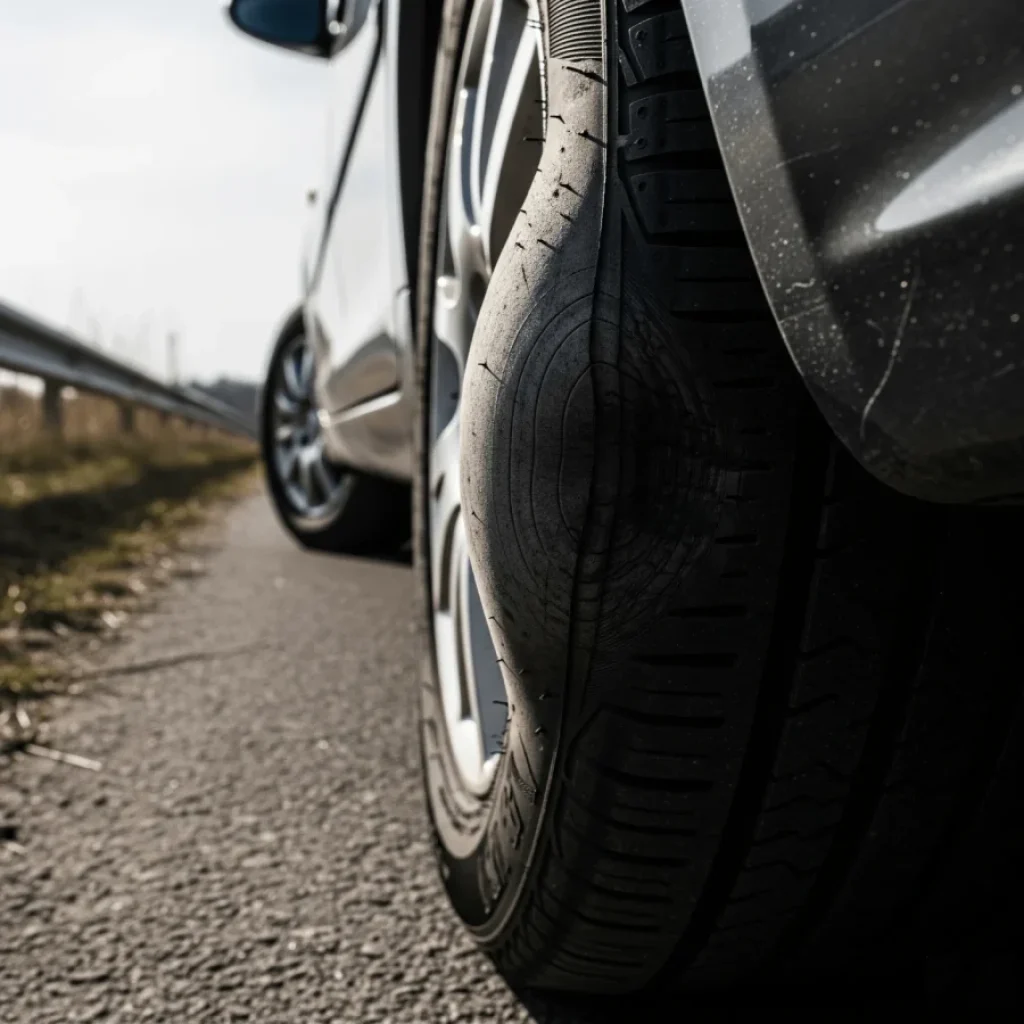
A bubble on a tire is a sign of serious internal structural failure. Think of it less as a “bubble” and more as a tire aneurysm—a weak spot that’s getting ready to burst. It’s one of the most hazardous conditions I see on a vehicle.
The Anatomy of a Tire Bubble
Your tires aren’t just solid rubber; they are complex structures made of layers of rubber, fabric, and steel belts. A tire bubble forms when a sharp impact—like hitting a pothole—causes the innermost layer of the tire (the inner liner) to tear.
When this happens, pressurized air escapes from the main chamber and forces its way between the internal layers. This process is called delamination. The bulge you see is air trapped where it doesn’t belong, pushing the flexible outer sidewall outwards.
This bulge represents a catastrophic failure of the tire’s structural integrity. It is now incredibly vulnerable to a tire blowout, which can cause a complete loss of vehicle control. According to the National Highway Traffic Safety Administration (NHTSA), tire failure is a contributing factor in over 11,000 traffic crashes each year. This isn’t a cosmetic issue; it’s a critical safety failure.
First Things First: What to Do Immediately if You See a Bubble in Your Tire
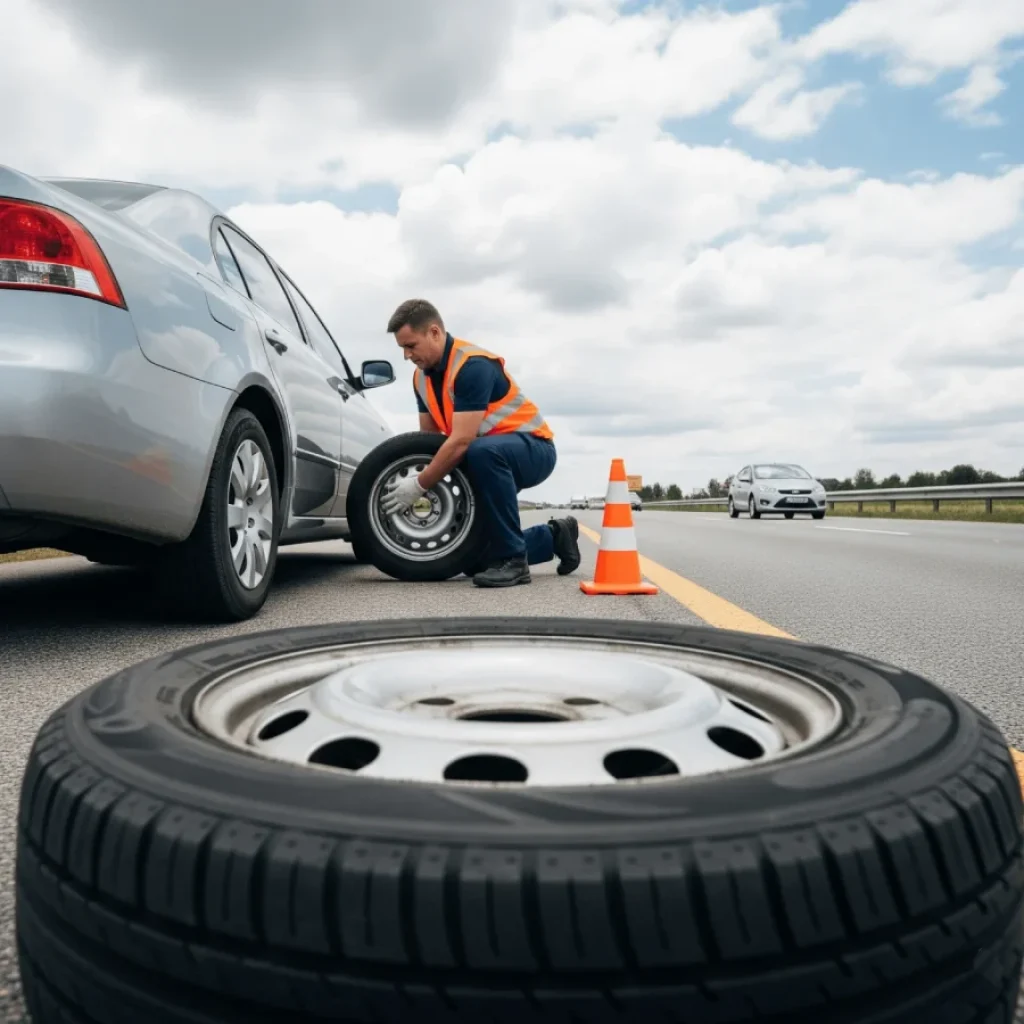
If you notice a bubble while driving or during a walk-around inspection, your immediate actions are critical for your safety. Do not ignore it or assume you can “deal with it later.”
Here is your immediate, step-by-step action plan:
- Pull Over Safely: As soon as you can, find a safe place to pull off the road. Avoid driving at high speeds or making sudden maneuvers. The stress could cause the tire to blow out.
- Perform a Visual Inspection: Once safely parked, look closely at the bubble. Note its size and location (is it on the flat tread or the vertical sidewall?). A sidewall bubble is the most common and dangerous type.
- Check Your Other Tires: The jolt that damaged one tire could easily have damaged another. Carefully inspect all four tires for similar signs of damage.
- Put on Your Spare Tire: The single safest thing you can do is to remove the damaged tire and install your spare tire. Do not attempt to drive to a repair shop on the bubbled tire.
- Call for Roadside Assistance: If you don’t have a spare or aren’t comfortable changing a tire, call for a tow service. Organizations like AAA are equipped to handle this safely. It’s far better to pay for a tow than to risk a dangerous accident. For more on this, see our guide on 7 useful information you should know about car accidents.
What Causes Bubbles in Tires? (And How to Prevent Them)
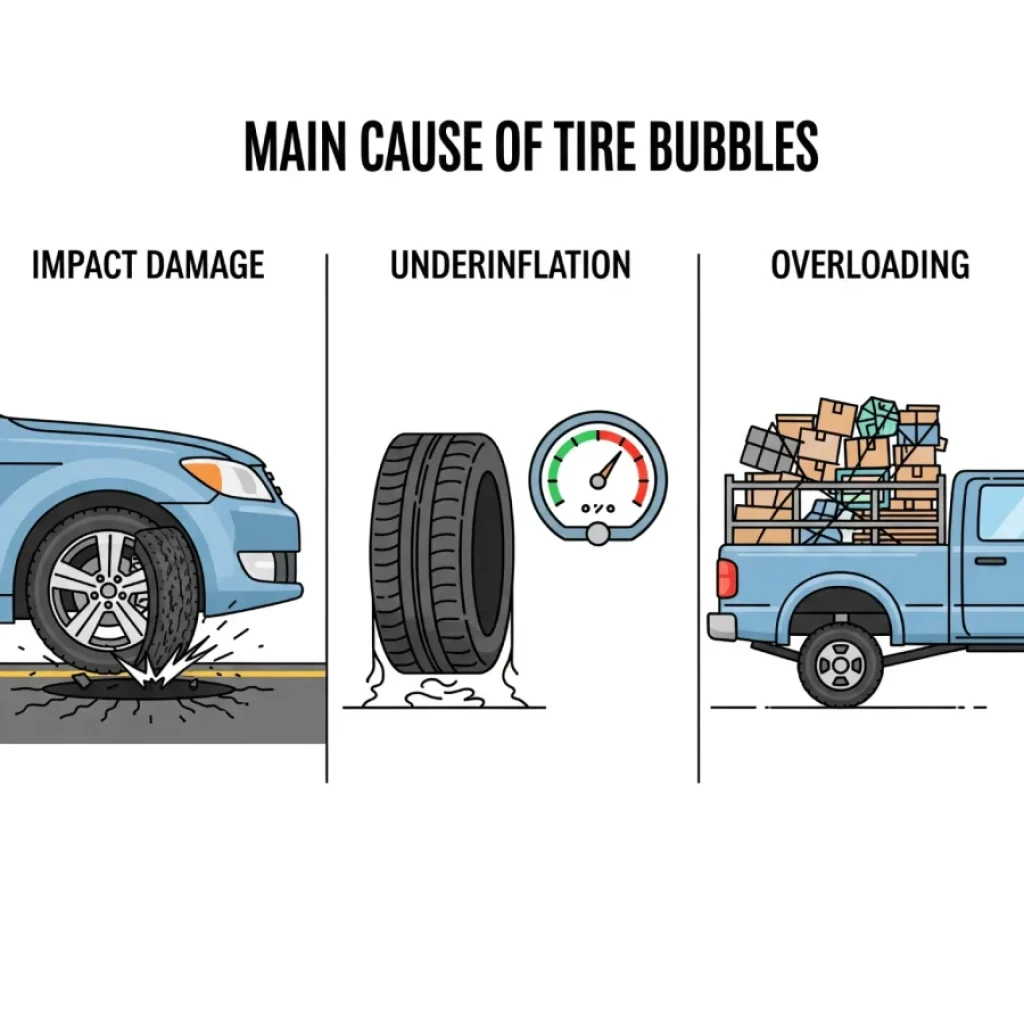
In my experience, 99% of tire bubbles are caused by some form of impact or improper care. They rarely just appear on their own.
The Most Common Culprits
- Impact Damage: This is the number one cause. Hitting a deep pothole, running into a curb, or driving over road debris can pinch the tire against the wheel, severing the internal structure.
- Underinflation/Overloading: Driving with low tire pressure causes the sidewalls to flex excessively, generating heat and stress that can lead to internal failure. Similarly, loading your vehicle beyond its weight capacity puts immense strain on your tires.
- Manufacturing Defects: While extremely rare with reputable brands like Michelin or Goodyear, a manufacturing flaw can create a weak spot. If the tire is relatively new and shows no signs of impact, it might be covered by a Road Hazard Warranty or the manufacturer’s warranty. Check the tire’s DOT Number on the sidewall; it tells you the week and year it was made, which is crucial for any warranty claim.
Your 4-Step Prevention Checklist
- Maintain Proper Tire Pressure: Check your tire pressure monthly with a quality tire pressure gauge. The correct pressure is listed on a sticker inside your driver’s side door jamb, not on the tire itself.
- Avoid Road Hazards: Be an active driver. Safely steer around potholes and avoid hitting curbs when parking or turning.
- Don’t Overload Your Vehicle: Know your vehicle’s payload capacity (found in the owner’s manual) and respect it.
- Perform Regular Inspections: Once a month, and before any long road trip, do a quick walk-around and look at your tires. It takes 60 seconds and is the best way to spot trouble early.
The Hard Truth: Can a Tire Bubble Be Fixed?
I get asked this question constantly, and my answer is always the same, direct, and unambiguous.
No, a tire bubble cannot be repaired safely.
Why Patches and Plugs Won’t Work
Tire repair kits with patches or plugs are designed to seal a simple puncture in the tread area. A bubble is not a puncture; it’s a structural failure. The strong internal cords that hold the tire together have been broken.
- A patch cannot fix broken structural cords.
- A plug cannot restore strength to the sidewall. Attempting to “repair” a bubble is like trying to fix a broken bone with a band-aid. It ignores the real damage and gives a false, and incredibly dangerous, sense of security.
Myth-Busting: Dangerous “Fixes” You Should Never Try
On internet forums, you might see some truly terrible advice. Let me set the record straight on a few common myths:
- Myth: “You can just pop the bubble and patch the hole.” Fact: This is extremely dangerous. You could trigger a violent blowout, and even if you didn’t, the patch would not hold against the damaged structure.
- Myth: “My tire bubble went away on its own.” Fact: This is physically impossible. The air pressure inside the tire may decrease when it’s cold, making the bubble appear smaller, but the internal tear is still there. As soon as the tire warms up from driving, the bubble will return, and the risk of a blowout remains.
Your Next Step: Getting a Replacement Tire
Once you have your spare on, your very next stop should be a reputable tire shop, like a Discount Tire or Costco Tire Center.
How Much Does a New Tire Cost?
The cost to replace a single tire can vary widely, typically from $80 to over $350. The price depends on the brand (Pirelli, Bridgestone, etc.), size, and type of tire. A standard tire for a Toyota Camry will be much less expensive than a specialized, low-profile tire for a performance vehicle.
Should I Replace One Tire or More?
While you might be tempted to just replace the one damaged tire, the best practice is to replace tires in pairs. This means replacing both front tires or both rear tires at the same time.
Why? Because tires need to have similar tread depths to ensure your vehicle handles predictably. A new tire paired with a half-worn old tire can cause pulling, instability, and even trigger issues with ABS and traction control systems, particularly on All-Wheel Drive (AWD) vehicles. Replacing in pairs also ensures you get the most out of your next wheel alignment.
Frequently Asked Questions (FAQ)
How long can I drive on a tire with a bubble?
You shouldn’t drive on it at all, other than to slowly and carefully pull over to a safe location off the road. Every rotation is a gamble with a blowout.
Can a bubble in a tire cause vibration?
Absolutely. A bubble creates an out-of-round shape, which will almost certainly cause vibrations or a wobbling sensation, especially at higher speeds. If you suddenly feel a new vibration, it’s a critical sign to pull over and inspect your tires immediately. A persistent vibration could also be a symptom of other issues, like a weak battery causing rough running.
What’s the difference between a bubble on the sidewall versus the tread?
A sidewall bubble is from impact damage. A bubble or bulge on the flat tread surface is usually a sign of tire separation, where the steel belts are detaching from the tire casing. Both are extremely dangerous and mean the tire must be replaced immediately.
Will a tire bubble fail a state vehicle inspection?
Yes, unequivocally. A tire with a visible bubble, bulge, or any other structural damage is an automatic failure in any state vehicle safety inspection, as outlined by agencies like the DOT and state DMVs.
A Final Word of Advice from Your Technician
In my years as a mechanic, I’ve learned that cars often give us warning signs before a major failure. A bubble in your tire is one of the loudest, clearest warnings you will ever get.
Don’t ignore it. Don’t delay. Dealing with it correctly and immediately by replacing the tire is the only safe solution. Your tires are the only four points of contact between your vehicle and the road. By taking a few minutes each month for a quick tire inspection and maintaining them properly, you’re not just protecting your investment—you’re protecting yourself, your passengers, and everyone else on the road.
Drive safe.



